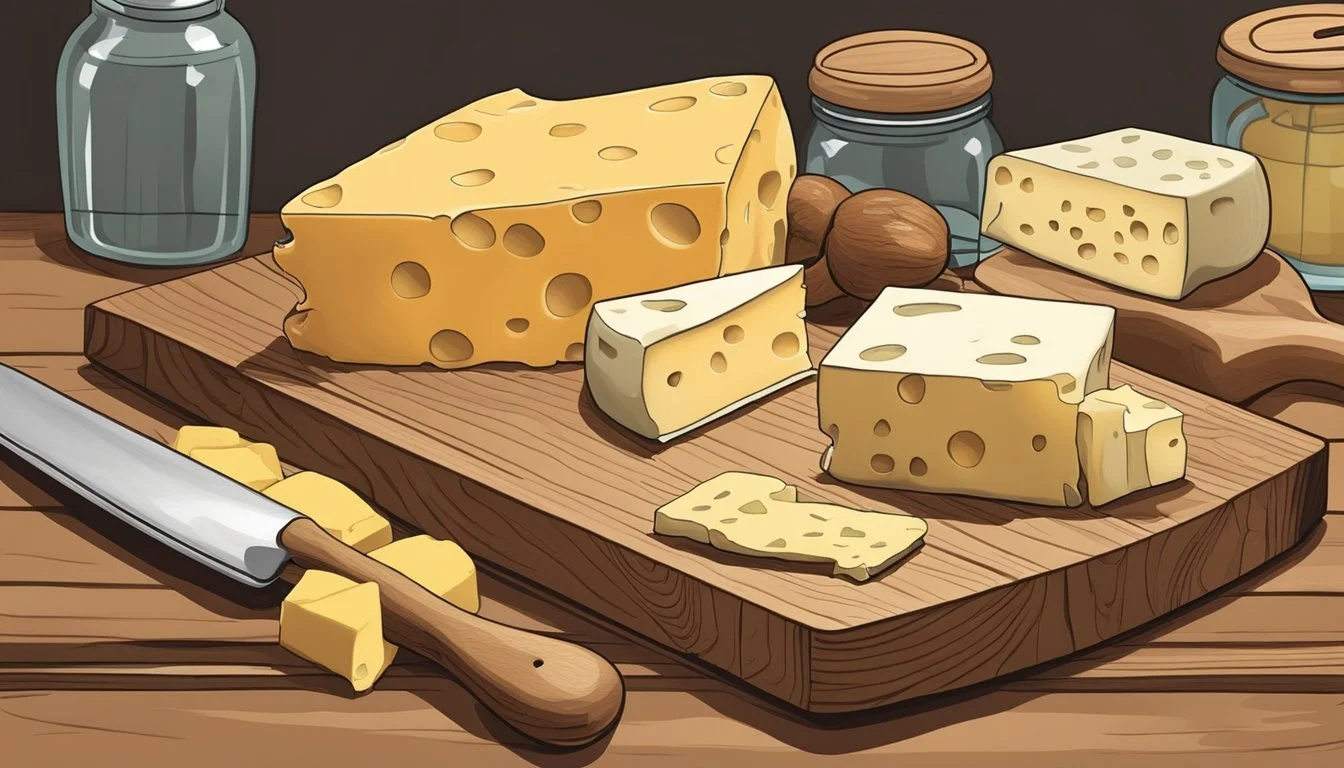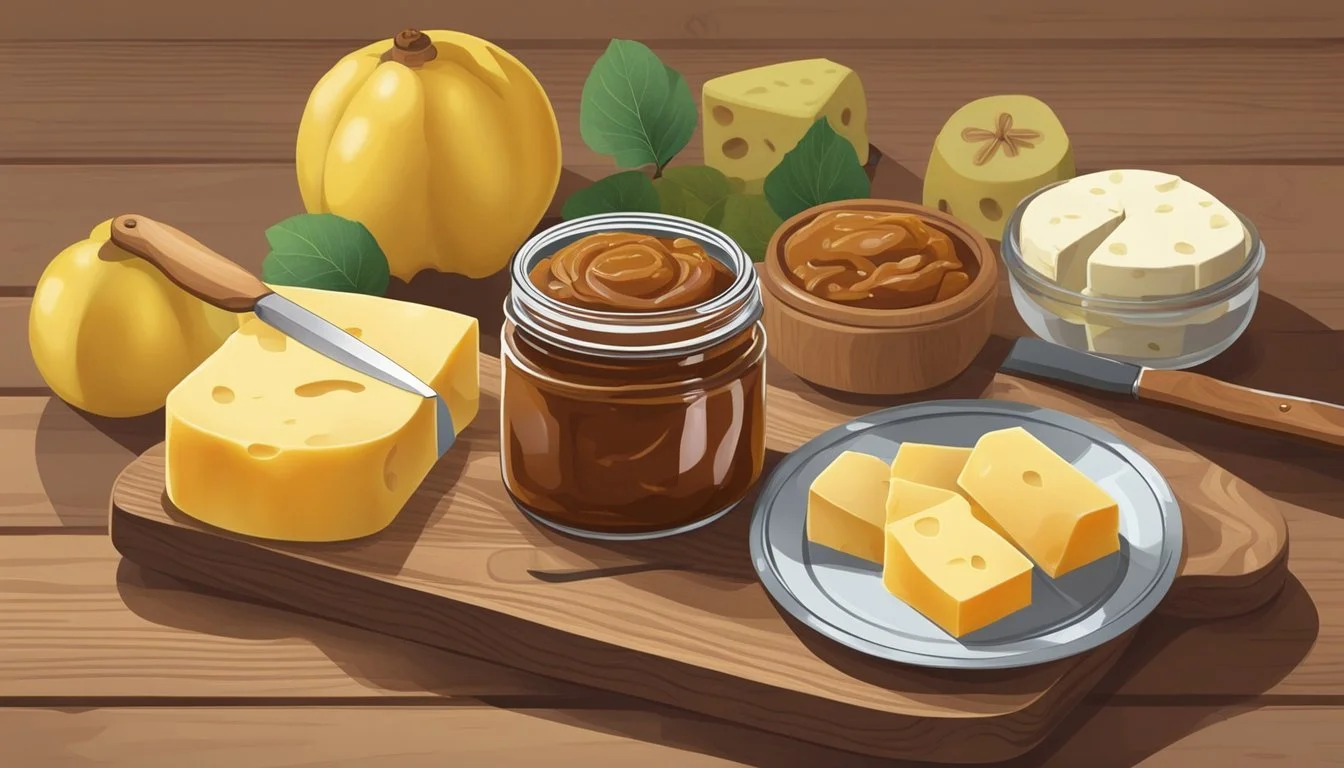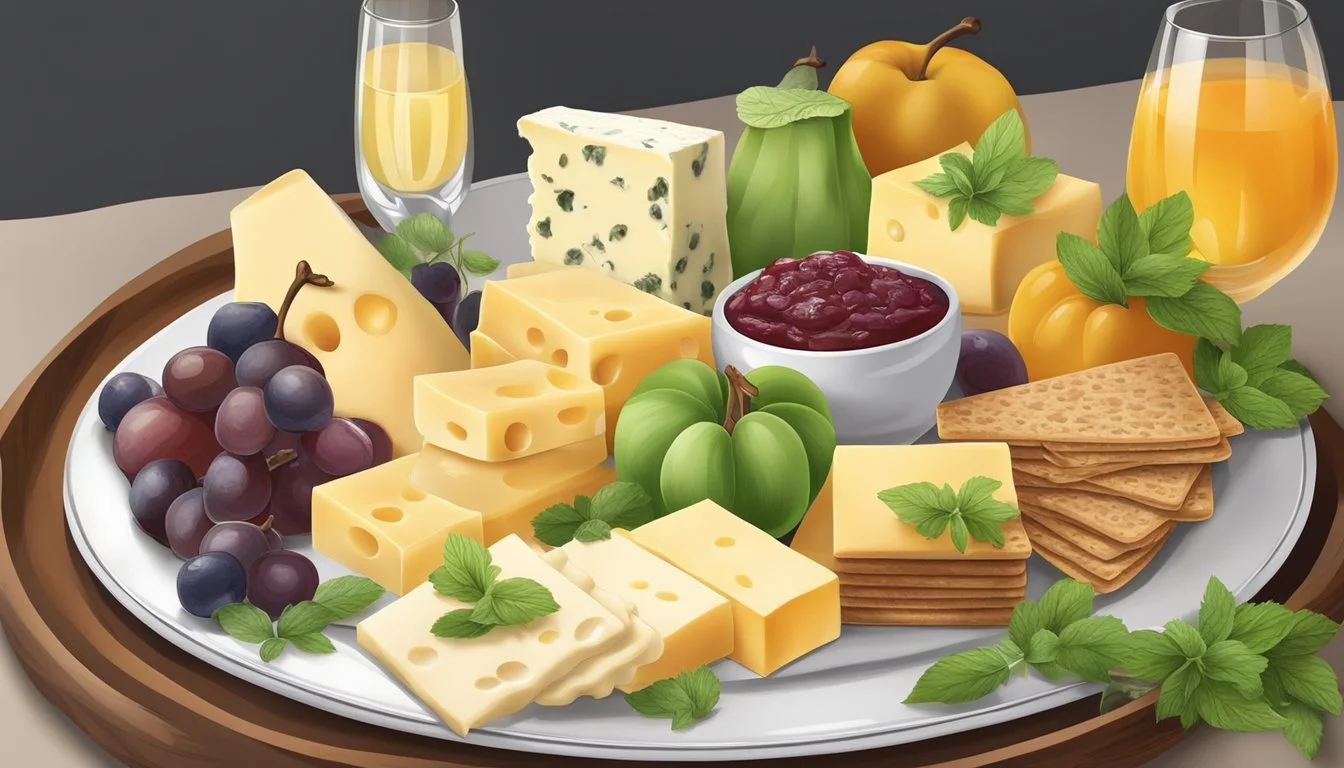How to Cook with Quince Paste
Mastering Cheese Pairings
Quince paste, known for its sweet and slightly tart profile, is traditionally used as a condiment in various cuisines. Its firm texture and rich, fruity flavor make it an excellent companion to cheese, creating a balance of tastes and adding complexity to cheese pairings. The versatility of quince paste allows it to complement a wide range of cheeses, from the nutty and firm Manchego to the robust and creamy blue varieties.
When selecting cheese to pair with quince paste, contrasting flavors often yield the best results. For instance, the sharpness of aged cheddar contrasts delightfully with the sweetness of quince paste, while the paste's intensity is well-matched with the boldness of blue cheeses (What wine goes well with blue cheeses?) such as Roquefort and Gorgonzola. The goal is to enhance the tasting experience by using the paste to highlight the distinct characteristics of each cheese.
Incorporating quince paste into a cheese board not only adds a visual element but also invites a play of textures and flavors. It can be elegantly presented alongside slices of cheese or as a base for canapés and appetizers. Additionally, quince paste serves as a resourceful ingredient that can be used in various culinary applications to elevate the cheese pairing experience.
Understanding Quince Paste
Quince paste, often known as membrillo in Spain, is a savory and sweet delicacy originating from the Mediterranean region. It's a concentrated form of quince, a fruit closely related to apples and pears. When ripe, quince is hard and sour, but when cooked with sugar, it transforms into a delightfully fragrant and sweet confection that is perfect for cheese pairings.
The making of quince paste involves cooking down the flesh of the quince fruit with sugar until it thickens into a dense, jelly-like consistency. The traditional Spanish membrillo typically adopts a deep orange or red color, depending upon the cooking time and the natural hue of the fruit.
Ideal Cheese Pairings:
Manchego Cheese: The nutty flavor of Manchego cheese complements the sweet-tartness of quince paste.
Aged Cheddar: Offers a sharp contrast to the sweetness, enhancing both flavors.
Blue Cheese: Varieties like Roquefort or Gorgonzola provide a bold flavor that matches the intensity of the paste.
In texture and flavor, quince paste is thick and malleable, with a sweetness that isn't overpowering. This allows it to pair well with a broad range of cheeses, creating a balance between sweet and savory that is highly valued on cheese boards.
Notably, quince paste's firmness allows it to be sliced cleanly, which is especially conducive to serving alongside firm cheeses for an appetizing presentation. Its unique flavor profile makes quince paste a staple in crafting an impressive and well-rounded cheese board.
Cheese Pairing Basics
When selecting cheese to pair with quince paste, one should consider the intensity and texture of both components. Quince paste, with its sweet and slightly tangy profile, complements a variety of cheeses.
Manchego: This firm, sheep's milk cheese offers a nutty flavor that harmonizes well with quince paste.
Aged Cheddar: The sharpness of aged cheddar provides a flavorful contrast that enhances the quince paste's sweetness.
Blue Cheeses: Varieties such as Roquefort or Gorgonzola have a bold taste that stands up to the strength of the paste.
The salt content in cheese can also play a key role in pairing. Salty cheeses help to balance the sweetness of the quince paste, creating a well-rounded taste experience.
Here are common pairings:
Cheese Type Pairing Note Goat Cheese Its tangy flavor works well with the sweetness of quince. Brie The creamy texture pairs smoothly with the dense paste. Cheddar A classic pairing, where sharp meets sweet.
In addition to the flavor, the texture of cheese should also be a consideration:
Soft cheeses like brie offer a creamy counterpoint to the dense texture of quince paste.
Hard cheeses, such as Manchego, provide a contrasting firmness.
In summary, when pairing cheese with quince paste, look for flavors that either complement or boldly contrast with the paste, while also considering the interplay of textures and salt content. This approach ensures a confident and enjoyable experience for the palate.
Selecting the Right Cheeses
When assembling a cheese board that includes quince paste, the selection of cheeses is critical to create a harmonious balance of flavors. Each cheese offers its unique taste profile, and some pair particularly well with the sweet and tangy characteristics of quince paste.
Manchego is an ideal candidate, with its nutty flavor enhancing the quince paste's sweetness. This semi-hard cheese from Spain boasts a firm texture and buttery taste, making it a classic pairing with quince.
Aged cheddar provides a delightful contrast, thanks to its sharpness. It's a versatile cheese that stands up to the strong flavors of quince paste. Its slightly crumbly texture and deep flavor profile complement the quince paste's richness.
For those seeking more intense pairings, blue cheeses like Roquefort or Gorgonzola can be excellent choices. Their bold and piquant notes provide a robust flavor that can keep pace with the pronounced intensity of the quince paste.
Here's a quick guide to selecting cheeses:
Cheese Type Characteristics Pairing Notes with Quince Paste Manchego Nutty, firm, buttery Enhances sweetness, classic pairing Aged Cheddar Sharp, slightly crumbly Offers a tangy contrast, versatile Blue Cheese Bold, piquant Stands up to quince paste's intensity Parmigiano-Reggiano Nutty, granular, aged Adds depth with savory umami notes
While shopping at cheese shops, consider the rind of the cheeses as well. Cheeses with natural rinds, like Parmigiano-Reggiano, might be shaved or grated over servings of quince paste for an added textural experience.
Paired thoughtfully, cheese and quince paste can elevate a simple cheese board to an exquisite culinary adventure, offering a symphony of flavors with each pairing.
Preparing Quince Paste for Pairing
When preparing quince paste for a cheese pairing, one must emphasize a balance between the paste’s natural sweetness and its compatibility with various cheese flavors. Quince paste, traditionally known as membrillo, is a sweet, dense jam that marries well with the creamy textures and distinct tastes of different cheeses.
To begin, select ripe quinces, wash them, then cut into wedges, discarding the core. Place the wedges in a pot with the peel of a lemon—the acidic hint from the lemon juice assists in balancing the quince’s sweetness. Cover with water and bring to a boil. Once boiling, reduce the heat and let the quinces simmer until they become fork-tender, typically around 20 to 30 minutes.
After cooking, drain the quinces and remove the lemon peel. For a smooth consistency crucial for pairing, puree the fruit in a food processor. Then, pass the puree through a sieve to remove any remaining lumps. The next step involves returning the smoothened puree to the pot and adding sugar—approximately the same weight as the cooked quince.
Cook this mixture on medium heat, stirring frequently until it thickens. The transformation is complete once it displays a deep, reddish hue and detaches easily from the sides of the pot. Pour the mixture onto a tray lined with parchment paper and chill until firm.
Once cooled and set, the quince paste can be cut into slices or shapes to complement a variety of cheeses. A firm texture makes it easier to handle and serve. Its sweetness pairs well with Manchego, aged Cheddar, or bold blue cheeses, where its rich taste provides a counterpoint to the salty and savory notes of the cheese.
Perfect Pairing Combinations and Ideas
When pairing quince paste with cheese, one aims to balance the sweet and tangy flavors of the paste with the savory and sometimes sharp flavors of cheese. A classic companion to quince paste is Manchego, a Spanish cheese that echoes the paste's richness with its own nutty notes. The duo often finds a place on a tapas platter, appreciated for the harmony they bring to the palate.
For those building a more comprehensive platter, consider incorporating the following:
Aged Cheddar: Its sharp character contrasts delightfully with the sweetness of quince paste.
Blue Cheese Varieties: Bold cheeses like Roquefort or Gorgonzola stand up to the intense flavor of the paste.
Nuts: Marcona almonds add a crunchy texture and a buttery flavor that complements the quince paste.
Dried Fruits: Balance the plate with a variety of dried fruits that echo the tartness of the paste.
Fresh Fruits: Thinly sliced pear or apple provides a juicy, fresh contrast to the denser paste and cheeses.
Olives: Offer a briny counterpoint that cleanses the palate.
In the spirit of the holidays, these pairings can be complemented by a carefully selected bottle of wine, enhancing the collective flavors. Red wines with berry notes can lift the profile of a sharper cheese, while a crisp white may highlight the fresher elements on the platter.
One might use a small tin or ceramic dish for serving the quince paste, allowing guests to spoon a perfect amount onto their chosen cheese and accompaniments. This approach encourages experimentation and personalization of each bite.
Remember, the key to a successful cheese pairing is to balance flavors and textures, creating a diverse and enjoyable tasting experience.
Serving and Presentation
When incorporating quince paste into cheese pairings, presentation plays a crucial role in enhancing the overall tasting experience. The paste's vibrant hue and firm texture make it an attractive addition to any cheese board or charcuterie platter.
For Cheese Boards:
Start by slicing the quince paste into thin pieces. These can be artfully arranged on the board amidst a variety of cheeses. Pairing suggestions include:
Bold Cheeses: A slice of Roquefort or Gorgonzola, with their strong, pungent flavors, balances the sweetness of quince paste.
Aged Cheeses (What wine goes well with aged cheeses?): Match the nutty notes of an aged cheddar with quince paste for a contrast of sharp and sweet flavors.
Mild Cheeses: For a more delicate pairing, a slice of Manchego alongside quince paste enhances the cheese's subtle flavors.
As an Appetizer:
Top crostini or crackers with a thin layer of quince paste, followed by your cheese of choice, and broil briefly in the oven to meld the flavors.
Rolled with cheese into puff pastry strips, then baked until golden, makes for an enticing appetizer that showcases the quince paste.
With Roasted Meats (What wine goes well with roasted meats?):
Quince paste can be served as a condiment with roasted meats, highlighting its versatility beyond the cheese board.
For Dessert:
Transitioning quince paste to a dessert option, consider pairing it with a milder cheese and serving it alongside fresh fruit or a fruit tart.
With each serving suggestion, it's important to provide guests with utensils for spreading the paste and knives for the cheeses. The goal is to create a harmonious combination of tastes and textures, elevating both the quince paste and the accompanying cheeses.
Pairing Quince Paste with Wines
When selecting wines to accompany quince paste in a cheese pairing, one seeks balance and harmony in flavors. Portuguese wines offer delightful options, given Portugal's historic production of quince marmelada. A tawny Port, with its nutty and caramel notes, complements the sweet and tart nature of quince paste.
For those who prefer red wine, a Zinfandel (Zin) from San Francisco (SF) or Californian vineyards, with its bold fruitiness and spice, can stand up to the richness of both the paste and robust cheeses.
Wine Type Characteristics Cheese Pairing Tawny Port Nutty, caramel notes Blue cheeses, Aged Cheddar Zinfandel Fruity, spicy Manchego, Strong Blue Cheeses
Sweetness, acidity, and tannins are considerations when one pairs wines. The goal is to either complement or interestingly contrast the quince paste. Tawny Port with its inherent sweetness and Zinfandel's berry-like zest are confident choices.
Those seeking a lighter pairing might consider a Riesling or a crisp Sauvignon Blanc. These wines bring out the fruitiness without overwhelming with sweetness, offering a clear and neutral counterpoint to the quince paste on the cheeseboard.
It is the careful balancing of the wine's profile with the sweet and nuanced quince paste that makes for an exquisite tasting experience.
Homemade Quince Paste Recipes
When it comes to preparing homemade quince paste, the selection of ingredients and the cooking process are crucial. Quince paste, also known as Membrillo, pairs exquisitely with a range of cheeses, enhancing the flavors of any cheese platter.
Ingredients:
Quinces
Granulated sugar or brown sugar
Lemon juice
Water
Instructions:
Start by prepping the quinces. They should be peeled, cored, and chopped into chunks. Immersing the fruit in lemon water can minimize browning.
Cook the quince pieces in water. They should be covered and simmered until fork-tender.
Once cooked, the fruit is drained and then pureed until smooth, using a food processor or blender.
Measure the puree, then mix it with an equal amount of sugar. If you prefer a less sweet taste, the sugar ratio can be adjusted slightly.
Combine the puree and sugar with the juice of a lemon. Cook the mixture on medium heat, stirring continuously to prevent burning.
The paste is ready when it is thick and has a deep, amber color. It should hold its shape when stirred.
Pour it into a prepared pan, smooth the surface, and let it cool down completely before cutting.
For an intriguing twist, one may incorporate flavors like vanilla to the quince paste. Whether used for baking a quince cake, creating quince jam, or achieving a decadent quince syrup, be patient as quince paste requires slow cooking to achieve its characteristic consistency, perfect for pairing with cheeses in desserts and diverse savory dishes.
Accompaniments Beyond Cheese
While quince paste is often paired with cheese, its applications extend to a variety of other foods, enriching dishes with its sweet yet tart profile.
Yogurt: A dollop of quince paste stirred into plain or Greek yogurt transforms a simple snack into a nuanced treat. The yogurt's creaminess complements the quince paste's texture and taste.
Granola: For a breakfast twist, quince paste can be incorporated into homemade granola recipes. It adds a unique sweetness that pairs well with the oats and nuts, such as pecans, providing additional nutrients and flavor.
Pumpkin: In a seasonal dish, quince paste pairs with pumpkin to create a harmonious blend of autumn flavors. Whether in a pie or as a layered dessert, the combination is nutritious and flavorful.
Persimmon: As another fall fruit, persimmon's honey-like sweetness is enhanced when served with quince paste. Together, they can create a compote that serves as a perfect accompaniment to desserts or savory dishes.
Poultry: Brushing quince paste onto chicken before baking infuses the meat with a distinct glaze, giving it a delightful balance of sweetness and tartness.
Accompaniment Suggested Use Yogurt Mix with quince paste for a sweet addition. Granola Bake into homemade bars or sprinkle on top. Pumpkin Combine in desserts for a twist on tradition. Persimmon Make a compote as a dessert or dish topping. Chicken Use as a glaze before roasting.
Additionally, quince paste can serve as a base for sauces such as applesauce or cranberry sauce, imparting a deeper fruit flavor that blends well with the respective fruit components. Pairing quince paste with a variety of foods allows chefs and home cooks alike to explore new culinary territories with confidence.
Health Benefits and Nutritional Information
Quince paste, commonly known as 'membrillo', derives from the quince fruit, which is celebrated for its nutritional benefits. This fragrant fruit is rich in fiber, a crucial component for digestive health. A serving of quince paste retains some of this fiber, which assists in regulating blood sugar levels and supporting bowel regularity.
Vitamins and Minerals: Quince is a good source of several essential vitamins and minerals. This includes vitamin C, which boosts the immune system, and vitamin A, known for maintaining healthy skin and vision. The mineral content includes potassium, which is vital for heart health, and copper, essential for red blood cell formation.
Antioxidants: This fruit paste contains antioxidants that help to fight free radicals in the body, potentially reducing the risk of chronic diseases and aiding in the maintenance of overall health.
Nutrient Benefit Dietary Fiber Aids in digestion and blood sugar regulation Vitamin C Enhances immunity Vitamin A Supports skin and eye health Potassium Contributes to heart health Copper Essential for blood cell formation
When considering the culinary use of quince syrup, one may find it to be a sweeter, more concentrated form of the fruit, though it may contain less fiber due to processing. Still, the syrup can provide a delightful flavor enhancement to dishes while imparting some nutritional benefits.
As an accompaniment for cheese pairings, quince paste offers a natural sweetness and complexity that enhances the flavors of various cheeses. Its nutritional attributes contribute healthfully to a well-considered cheese board, allowing for both an indulgence in taste and a consideration for well-being.
Storing and Preserving Quince Paste
When storing quince paste, one must ensure it is kept in optimal conditions to maintain its quality and flavor for cheese pairings. Refrigeration plays a critical role in prolonging the paste's shelf life. To refrigerate quince paste:
Wrap it tightly with plastic film to create a moisture-resistant barrier.
Line a container with parchment paper to prevent any moisture development, which can spoil the paste.
Store the paste in equal-sized pieces for consistency in both storage and use.
For proper storage, follow these guidelines:
Step Action Step 1 Cut quince paste into uniform pieces. Step 2 Tightly wrap each piece in plastic film. Step 3 Line a storage container with parchment paper. Step 4 Place the wrapped paste in the container. Step 5 Refrigerate to preserve freshness.
Storing quince paste in the refrigerator helps in slowing down the fermentation process, ensuring that the product remains fresh and fit for consumption over a more extended period. It is also essential to note that when buying quince paste, consumers should look for ones with a clear use-by date to ensure they are getting a fresh product. If stored correctly, refrigerated quince paste can last several months, ensuring that it’s ready for use when needed for various cheese pairings.
Concluding Thoughts on Quince Paste and Cheese Pairings
When pairing quince paste with cheese, the goal is to create a harmonious balance of flavors. Manchego is a classic choice; its nutty taste complements the sweet and tart notes of quince paste. Aged cheddar presents a pleasing contrast with its sharpness. For a bolder choice, blue cheeses bold enough to stand up to the quince paste's intensity can be considered.
Below is a table of pairings to enhance one's appreciation of quince paste and cheese:
Cheese Type Pairing Description Manchego Nutty, mild, and enhances the quince paste sweetness. Aged Cheddar Sharp and robust, offering a striking contrast. Blue Cheese Intense flavors pair well with the strong quince taste.
Incorporating these pairings into dishes requires a nuanced approach. For instance, a simple yet elegant pairing involves placing a slice of cheese and a dollop of quince paste atop a crostini to create a harmonious bite.
Ultimately, the pairing of quince paste and cheese is both an art and a science. It invites an exploration of flavors, where the sweet, condensed essence of quince provides a counterpoint to the savory depth of various cheeses. By selecting the appropriate cheese, one encourages a mutual enhancement that elevates the entire culinary experience.







